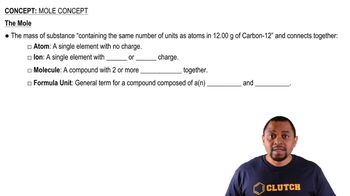The American Dental Association recommends that an adult female should consume 3.0 mg of fluoride (F-) per day to prevent tooth decay. If the fluoride is consumed in the form of sodium fluoride (45.24% F), what amount of sodium fluoride contains the recommended amount of fluoride?
Ch.3 - Molecules, Compounds & Chemical Equations
Chapter 3, Problem 81a,b
Determine the number of moles of hydrogen atoms in each sample. a. 0.0885 mol C4H10 b. 1.3 mol CH4
 Verified step by step guidance
Verified step by step guidance1
Step 1: Identify the molecular formula of the compound. In this case, it's C4H10, which means there are 4 atoms of Carbon (C) and 10 atoms of Hydrogen (H) in one molecule of the compound.
Step 2: Understand that a mole of a substance contains Avogadro's number (6.022 x 10^23) of entities (atoms, molecules, etc.). Therefore, one mole of C4H10 contains 10 moles of Hydrogen atoms.
Step 3: Use the given amount of moles of C4H10 to find the moles of Hydrogen atoms. Since one mole of C4H10 contains 10 moles of Hydrogen atoms, multiply the given moles of C4H10 by 10.
Step 4: The result from step 3 will give you the number of moles of Hydrogen atoms in the sample.

Verified video answer for a similar problem:
This video solution was recommended by our tutors as helpful for the problem above.
Was this helpful?
Key Concepts
Here are the essential concepts you must grasp in order to answer the question correctly.
Mole Concept
The mole is a fundamental unit in chemistry that quantifies the amount of substance. One mole contains approximately 6.022 x 10^23 entities, such as atoms or molecules. This concept allows chemists to convert between the mass of a substance and the number of particles it contains, facilitating stoichiometric calculations.
Recommended video:
Guided course

Mole Concept
Chemical Formula
A chemical formula represents the composition of a compound, indicating the types and numbers of atoms present. For example, C4H10 (butane) consists of 4 carbon (C) atoms and 10 hydrogen (H) atoms. Understanding the chemical formula is essential for determining the number of moles of specific atoms within a compound.
Recommended video:
Guided course

Skeletal Formula
Stoichiometry
Stoichiometry is the area of chemistry that deals with the relationships between the quantities of reactants and products in chemical reactions. It allows for the calculation of moles of different substances based on their ratios in a balanced equation. In this case, stoichiometry helps determine the number of moles of hydrogen atoms from the given moles of butane.
Recommended video:
Guided course

Stoichiometry Concept
Related Practice
Textbook Question
1
views
Textbook Question
Write a ratio showing the relationship between the molar amounts of each element for each compound. (See Appendix IIA for color codes.) (a)
Textbook Question
Write a ratio showing the relationship between the molar amounts of each element for each compound. (See Appendix IIA for color codes.) (b)
Textbook Question
Determine the number of moles of hydrogen atoms in each sample. c. 2.4 mol C6H12
1
views
Textbook Question
Determine the number of moles of hydrogen atoms in each sample. d. 1.87 mol C8H18
1
views
Textbook Question
Determine the number of moles of oxygen atoms in each sample. a. 4.88 mol H2O2 b. 2.15 mol N2O c. 0.0237 mol H2CO3 d. 24.1 mol CO2
2
views
